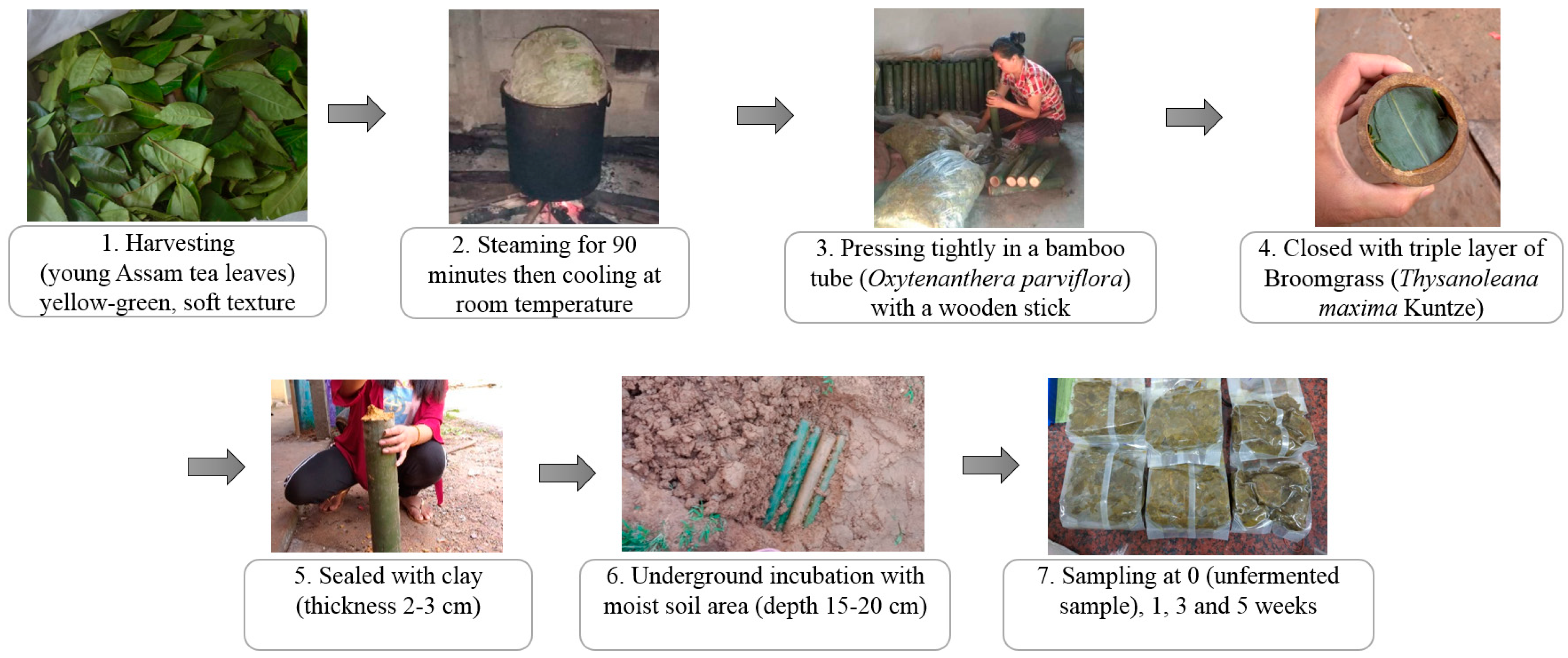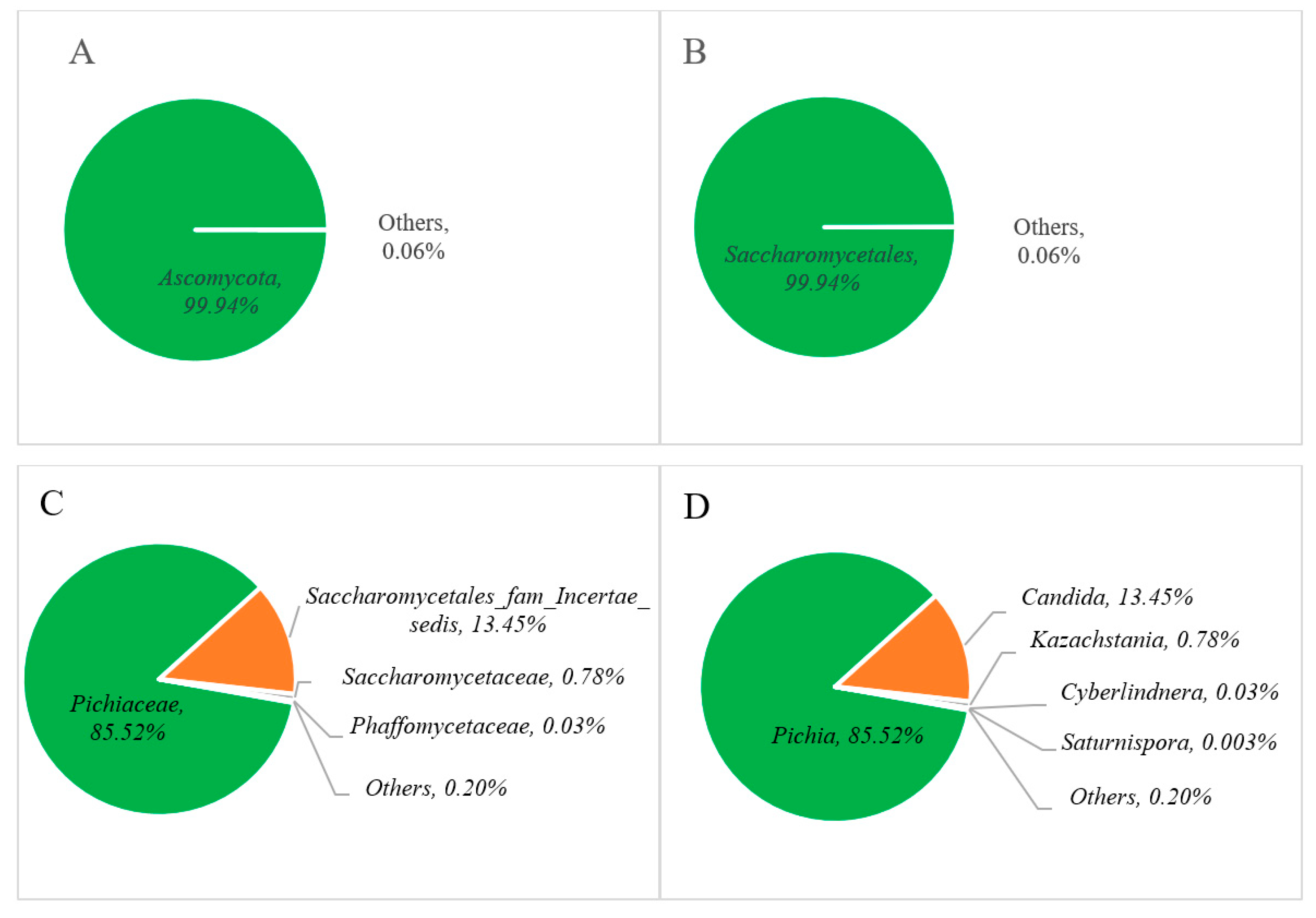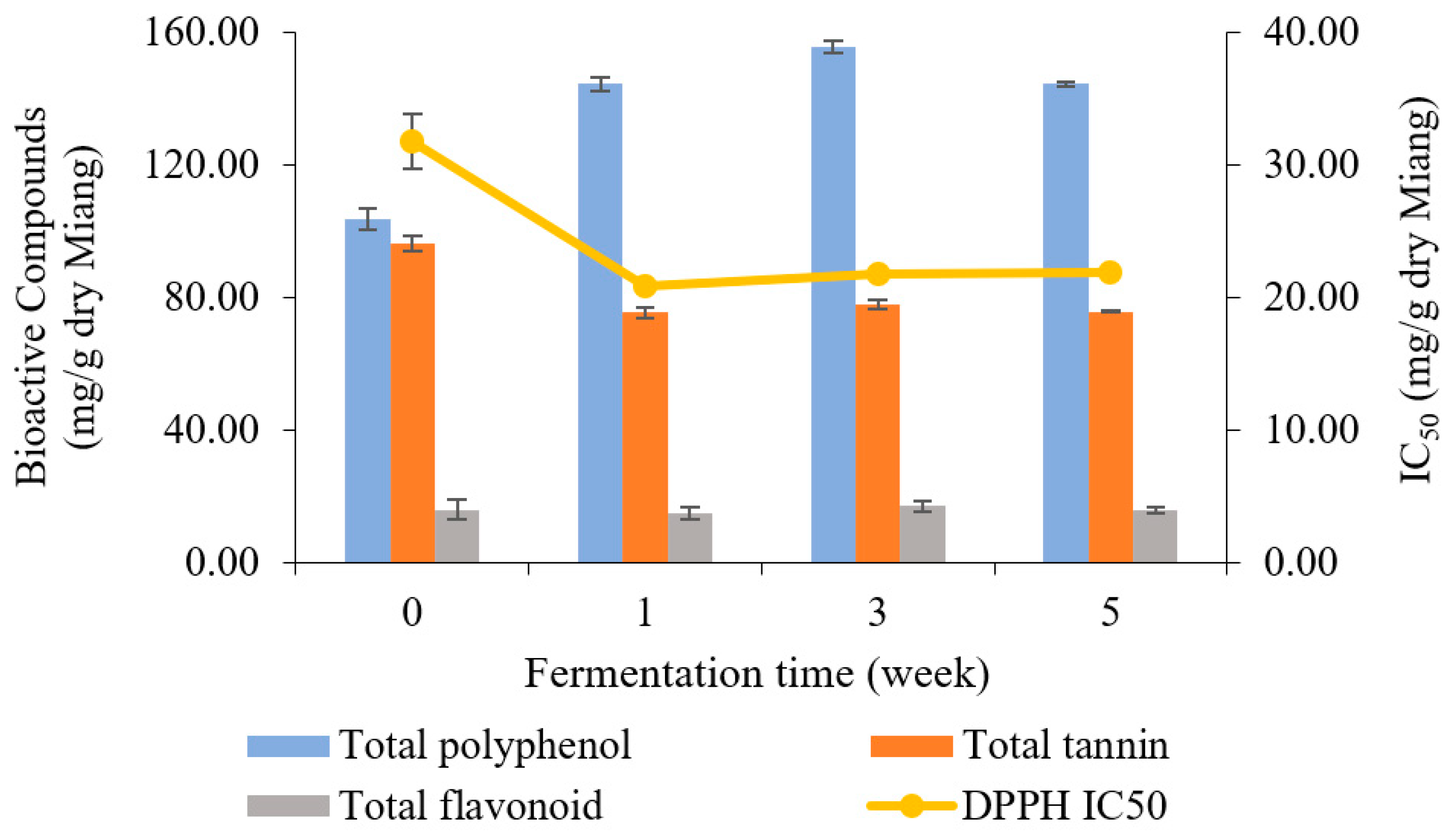Microbial Population and Physicochemical Properties of Miang Fermented in Bamboo Tubes by the Luar Ethnic Group in Lao PDR
Abstract
:1. Introduction
2. Materials and Methods
2.1. Raw Material and Chemicals
2.2. Sample Preparation
2.3. Enumeration of Microorganisms in the Miang Sample
2.4. Identification of Microbial Diversity of Miang Product by Next-Generation Sequencing
2.5. Chemical Properties of pH and Total Acid Titration
2.6. Investigation of Polysaccharide-Degrading Enzymes in Miang Fermentation
2.7. Proximate Analysis
2.8. Extraction of Bioactive Compounds
2.9. The Physical Properties of Color and Hardness
2.10. Statistical Analysis
3. Results and Discussion
3.1. Microbial Enumeration during Miang Fermentation
3.2. Microbial Diversity during Miang Fermentation Using Next-Generation Sequencing Analysis
3.3. pH and Total Acid Titration
3.4. Investigation of Polysaccharide-Degrading Enzymes in the Miang Fermentation Process
3.5. Proximate Analysis
3.6. Bioactive Compound Analysis
3.7. Physical Properties of Color and Hardness
4. Conclusions
Author Contributions
Funding
Institutional Review Board Statement
Informed Consent Statement
Data Availability Statement
Acknowledgments
Conflicts of Interest
References
- Kato, M.; Tamura, A.; Omori, M.; Nanba, A.; Miyagawa, K.; Nishmura, O.; Kameda, W. Changes of flavor during manufacturing process of Japanese fermented tea (Goishi-cha) and its characteristic. J. Home Econ. Jpn. 1994, 45, 527–532. [Google Scholar]
- Naba, A.; Nyein, N.M.; Win, S.Y.; Miyagawa, K. Post-heated and fermented edible teas and their dried forms. J. Home Econ. Jpn. 1999, 50, 639–646. [Google Scholar]
- Reichart, P.; Philipsen, H.; Mohr, U.; Geerlings, H.; Srisuwan, S. Miang chewing in northern Thai villagers. Trop. Geogr. Med. 1988, 40, 39–44. [Google Scholar] [PubMed]
- Huang, Y.; Xiao, X.; Cong, L.; Wu, M.; Yao, Y. A fermented tea with high levels of gallic acid processed by anaerobic solid-state fermentation. LWT Food Sci. Technol. 2016, 71, 260–267. [Google Scholar] [CrossRef]
- Mo, H.; Zhu, Y.; Chen, Z. Microbial fermented tea—A potential source of natural food preservatives. Trends Food Sci. Technol. 2008, 19, 124–130. [Google Scholar] [CrossRef]
- Van Driem, G. The Primordial Origins of Tea. In The Tale of Tea; Brill: Leiden, The Netherlands, 2019; pp. 1–38. [Google Scholar]
- Mougne, C.; MacLennan, R.; Atsana, S. Smoking, chewing and drinking in Ban Pong, northern Thailand. Soc. Sci. Med. 1982, 16, 99–106. [Google Scholar] [CrossRef] [PubMed]
- Preechapanya, P. Indigenous Ecological Knowledge about the Sustainability of Tea Gardens in the Hill Evergreen Forest of Northern Thailand. Ph.D. Thesis, Bangor University, Bangor, UK, 1996. [Google Scholar]
- Tamang, J.P.; Kailasapathy, K. (Eds.) Fermented Foods and Beverages of the World, 1st ed.; CRC Press: Boca Raton, FL, USA, 2010. [Google Scholar]
- Xiao, P.; Huang, Y.; Yang, W.; Zhang, B.; Quan, X. Screening lactic acid bacteria with high yielding-acid capacity from pickled tea for their potential uses of inoculating to ferment tea products. J. Food Sci. Technol. 2015, 52, 6727–6734. [Google Scholar] [CrossRef] [PubMed]
- Khanongnuch, C.; Unban, K.; Kanpiengjai, A.; Saenjum, C. Recent research advances and ethno-botanical history of miang, a traditional fermented tea (Camellia sinensis var. assamica) of northern Thailand. J. Ethn. Foods 2017, 4, 135–144. [Google Scholar] [CrossRef]
- Chupeerach, C.; Aursalung, A.; Watcharachaisoponsiri, T.; Whanmek, K.; Thiyajai, P.; Yosphan, K.; Sritalahareuthai, V.; Sahasakul, Y.; Santivarangkna, C.; Suttisansanee, U. The Effect of Steaming and Fermentation on Nutritive Values, Antioxidant Activities, and Inhibitory Properties of Tea Leaves. Foods 2021, 10, 117. [Google Scholar] [CrossRef]
- Phromrukachat, S.; Tiengburanatum, N.; Meechui, J. Assessment of active ingredients in pickled tea. Asian J. Food Agro-Ind. 2010, 3, 312–318. [Google Scholar]
- Sun, H.; Chen, Y.; Cheng, M.; Zhang, X.; Zheng, X.; Zhang, Z. The modulatory effect of polyphenols from green tea, oolong tea and black tea on human intestinal microbiota in vitro. J. Food Sci. Technol. 2018, 55, 399–407. [Google Scholar] [CrossRef]
- Chaikaew, S.; Baipong, S.; Sone, T.; Kanpiengjai, A.; Chui-Chai, N.; Asano, K.; Khanongnuch, C. Diversity of lactic acid bacteria from Miang, a traditional fermented tea leaf in northern Thailand and their tannin-tolerant ability in tea extract. J. Microbiol. 2017, 55, 720–729. [Google Scholar] [CrossRef] [PubMed]
- Horie, M.; Ruengsomwong, S.; Wannissorn, B. Field Research for Production Method of Miang: Post-Fermented Tea in Thailand. Jpn. J. Food Eng. 2020, 21, 125–137. [Google Scholar] [CrossRef]
- Kanpiengjai, A.; Chui-Chai, N.; Chaikaew, S.; Khanongnuch, C. Distribution of tannin-tolerant yeasts isolated from Miang, a traditional fermented tea leaf (Camellia sinensis var. assamica) in northern Thailand. Int. J. Food Microbiol. 2016, 238, 121–131. [Google Scholar] [CrossRef]
- Cao, Z.; Pan, H.; Li, S.; Shi, C.; Wang, S.; Wang, F.; Ye, P.; Jia, J.; Ge, C.; Lin, Q.; et al. In vitro evaluation of probiotic potential of lactic acid bacteria isolated from Yunnan De’ang pickled tea. Probiotics Antimicrob. Proteins 2019, 11, 103–112. [Google Scholar] [CrossRef] [PubMed]
- Unban, K.; Khatthongngam, N.; Shetty, K.; Khanongnuch, C. Nutritional biotransformation in traditional fermented tea (Miang) from north Thailand and its impact on antioxidant and antimicrobial activities. J. Food Sci. Technol. 2019, 56, 2687–2699. [Google Scholar] [CrossRef] [PubMed]
- Zhou, Y.; Drouin, P.; Lafrenière, C. Effect of temperature (5–25 °C) on epiphytic lactic acid bacteria populations and fermentation of whole-plant corn silage. J. Appl. Microbiol. 2016, 121, 657–671. [Google Scholar] [CrossRef] [PubMed]
- Losavatdy, S. Extension of Tea Production for Farmers. Bachelor’s Thesis, Faculty of Agriculture and Forest Resource, Souphanouvong University, Luang Prabang, Laos, 2018; p. 27. (in Lao). [Google Scholar]
- Khatthongngam, N.; Watina, N.; Unban, K.; Phongthai, S.; Khanongnuch, C. A selected β-mannanase producing bacilli capable of miang extract tolerant isolated from traditional fermented tea leaf from north Thailand. Food Appl. Biosci. J. 2019, 7, 1–16. [Google Scholar]
- Kodchasee, P.; Nain, K.; Abdullahi, A.D.; Unban, K.; Saenjum, C.; Shetty, K.; Khanongnuch, C. Microbial dynamics-linked properties and functional metabolites during Miang fermentation using the filamentous fungi growth-based process. Food Biosci. 2021, 41, 100998. [Google Scholar] [CrossRef]
- Chen, X.; Cao, Y.; Ding, Y.; Lu, W.; Li, D. Cloning, functional expression and characterization of Aspergillus sulphureus β-mannanase in Pichia pastoris. J. Biotechnol. 2007, 128, 452–461. [Google Scholar] [CrossRef]
- Yeoh, H.H.; Wee, Y.C. Leaf protein contents and nitrogen-to-protein conversion factors for 90 plant species. Food Chem. 1994, 49, 245–250. [Google Scholar] [CrossRef]
- Eom, S.H.; Park, H.J.; Jin, C.W.; Kim, D.O.; Seo, D.W.; Jeong, Y.H.; Cho, D.H. Changes in antioxidant activity with temperature and time in Chrysanthemum indicum L. (Gamguk) teas during elution processes in hot water. Food Sci. Biotechnol. 2008, 17, 408–412. [Google Scholar]
- Makkar, H.P.; Blúmmel, M.; Borowy, N.K.; Becker, K. Gravimetric determination of tannins and their correlations with chemical and protein precipitation methods. J. Sci. Food Agric. 1993, 61, 161–165. [Google Scholar] [CrossRef]
- Braca, A.; Fico, G.; Morelli, I.; De Simone, F.; Tomè, F.; De Tommasi, N. Antioxidant and free radical scavenging activity of flavonol glycosides from different Aconitum species. J. Ethnopharmacol. 2003, 86, 63–67. [Google Scholar] [CrossRef] [PubMed]
- Unban, K.; Chaichana, W.; Baipong, S.; Abdullahi, A.D.; Kanpiengjai, A.; Shetty, K.; Khanongnuch, C. Probiotic and antioxidant properties of lactic acid bacteria isolated from indigenous fermented tea leaves (Miang) of north Thailand and promising application in synbiotic formulation. Fermentation 2021, 7, 195. [Google Scholar] [CrossRef]
- Kangwan, N.; Kongkarnka, S.; Boonkerd, N.; Unban, K.; Shetty, K.; Khanongnuch, C. Protective effect of probiotics isolated from traditional fermented tea leaves (miang) from northern Thailand and role of synbiotics in ameliorating experimental ulcerative colitis in mice. Nutrients 2022, 14, 227. [Google Scholar] [CrossRef] [PubMed]
- Bo, B.; Kim, S.A.; Han, N.S. Bacterial and fungal diversity in Laphet, traditional fermented tea leaves in Myanmar, analyzed by culturing, DNA amplicon-based sequencing, and PCR-DGGE methods. Int. J. Food Microbiol. 2020, 320, 108508. [Google Scholar] [CrossRef]
- Unban, K.; Kochasee, P.; Shetty, K.; Khanongnuch, C. Tannin-tolerant and extracellular tannase producing Bacillus isolated from traditional fermented tea leaves and their probiotic functional properties. Foods 2020, 9, 490. [Google Scholar] [CrossRef] [PubMed]
- Puupponen-Pimia, R.; Nohynek, L.; Meier, C.; Kähkönen, M.; Heinonen, M.; Hopia, A.; Oksman-Caldentey, K.M. Antimicrobial properties of phenolic compounds from berries. J. Appl. Microbiol. 2001, 90, 494–507. [Google Scholar] [CrossRef]
- Klayraung, S.; Okonogi, S. Antibacterial and antioxidant activities of acid and bile resistant strains of isolated from miang. Braz. J. Microbiol. 2009, 40, 757–766. [Google Scholar]
- Unban, K.; Khatthongngam, N.; Pattananandecha, T.; Saenjum, C.; Shetty, K.; Khanongnuch, C. Microbial community dynamics during the non-filamentous fungi growth-based fermentation process of Miang, a traditional fermented tea of north Thailand and their product characterizations. Front. Microbiol. 2020, 11, 1515. [Google Scholar] [CrossRef]
- Liu, C.; Lin, H.; Wang, K.; Zhang, Z.; Huang, J.; Liu, Z. Study on the trend in microbial changes during the fermentation of black tea and its effect on the quality. Foods 2023, 12, 1944. [Google Scholar] [CrossRef]
- Di Cagno, R.; Coda, R. Fermentation foods: Fermented vegetable products. In Encyclopedia of Food Microbiology, 2nd ed.; Batt, C.A., Tortorello, M.L., Eds.; Academic Press: Oxford, UK, 2014; pp. 875–883. [Google Scholar]
- Stone, B.A.; Svensson, B.; Collins, M.E.; Rastall, R.A. Polysaccharide Degradation. In Glycoscience: Chemistry and Chemical Biology; Fraser-Reid, B.O., Tatsuta, K., Thiem, J., Eds.; Springer: Berlin/Heidelberg, Germany, 2008. [Google Scholar]
- Wang, Y.; Wu, J.; Lv, M.; Shao, Z.; Hungwe, M.; Wang, J.; Bai, X.; Xie, J.; Wang, Y.; Geng, W. Metabolism characteristics of lactic acid bacteria and the expanding applications in food industry. Front. Bioeng. Biotechnol. 2021, 9, 612285. [Google Scholar] [CrossRef]
- Liao, N.; Pang, B.; Jin, H.; Xu, X.; Yan, L.; Li, H.; Shao, D.; Shi, J. Potential of lactic acid bacteria derived polysaccharides for the delivery and controlled release of oral probiotics. J. Control. Release 2020, 323, 110–124. [Google Scholar] [CrossRef] [PubMed]
- Kumar, R.; Bohra, V.; Mk, M.; Wong, J.W. Food waste as a valuable carbon source for bioconversion-How microbes do miracles. In Good Microbes in Medicine, Food Production, Biotechnology, Bioremediation, and Agriculture; Springer: Berlin/Heidelberg, Germany, 2022; pp. 312–322. [Google Scholar]
- Kögel-Knabner, I. The macromolecular organic composition of plant and microbial residues as inputs to soil organic matter. Soil Biol. Biochem. 2002, 34, 139–162. [Google Scholar] [CrossRef]
- Hemsworth, G.R.; Dejean, G.; Davies, G.J.; Brumer, H. Learning from microbial strategies for polysaccharide degradation. Biochem. Soc. Trans. 2016, 44, 94–108. [Google Scholar] [CrossRef]
- Murugesan, G.S.; Angayarkanni, J.; Swaminathan, K. Effect of tea fungal enzymes on the quality of black tea. Food Chem. 2002, 79, 411–417. [Google Scholar] [CrossRef]
- Li, Q.; Li, Y.; Luo, Y.; Xiao, L.; Wang, K.; Huang, J.; Liu, Z. Characterization of the key aroma compounds and microorganisms during the manufacturing process of Fu brick tea. LWT Food Sci. Technol. 2020, 127, 109355. [Google Scholar] [CrossRef]
- Huang, F.F.; Yang, P.D.; Bai, S.L.; Liu, Z.H.; Li, J.; Huang, J.A.; Xiong, L.G. Lipids: A noteworthy role in better tea quality. Food Chem. 2023, 431, 137071. [Google Scholar] [CrossRef]
- Diether, N.E.; Willing, B.P. Microbial fermentation of dietary protein: An important factor in diet–microbe–host interaction. Microorganisms 2019, 7, 19. [Google Scholar] [CrossRef]
- Kieliszek, M.; Pobiega, K.; Piwowarek, K.; Kot, A.M. Characteristics of the proteolytic enzymes produced by lactic acid bacteria. Molecules 2021, 26, 1858. [Google Scholar] [CrossRef]
- Abdullahi, A.D.; Kodchasee, P.; Unban, K.; Pattananandecha, T.; Saenjum, C.; Kanpiengjai, A.; Shetty, K.; Khanongnuch, C. Comparison of phenolic contents and scavenging activities of Miang extracts derived from filamentous and non-filamentous fungi-based fermentation processes. Antioxidants 2021, 10, 1144. [Google Scholar] [CrossRef] [PubMed]
- Wispen, S.; Somsong, P.; Santivarangkna, C.; Tiyayon, P.; Chathiran, W.; Matthews, K.R.; Srichamnong, W. Changes in bioactive compounds, antioxidant activities and chemical properties of pickled tea by-product fermentation: Promising waste management and value-added product. Fermentation 2022, 8, 472. [Google Scholar] [CrossRef]
- Zhang, H.; Chen, Y.; Guo, Y.; Xu, W.; Wang, W.; Wu, S.; Huang, Y. Label-free quantification proteomics reveals the active peptides from protein degradation during anaerobic fermentation of tea. LWT 2021, 150, 111950. [Google Scholar] [CrossRef]
- Zhang, H.; Liu, Y.Z.; Xu, W.C.; Chen, W.J.; Wu, S.; Huang, Y.Y. Metabolite and microbiome profilings of pickled tea elucidate the role of anaerobic fermentation in promoting high levels of gallic acid accumulation. J. Agric. Food Chem. 2020, 68, 13751–13759. [Google Scholar] [CrossRef] [PubMed]
- Chen, L.; Liu, F.; Yang, Y.; Tu, Z.; Lin, J.; Ye, Y.; Xu, P. Oxygen-enriched fermentation improves the taste of black tea by reducing the bitter and astringent metabolites. Food Res. Int. 2021, 148, 110613. [Google Scholar] [CrossRef]
- Li, M.; Xiao, Y.; Zhong, K.; Wu, Y.; Gao, H. Delving into the biotransformation characteristics and mechanism of steamed green tea fermented by Aspergillus niger PW-2 based on metabolomic and proteomic approaches. Foods 2022, 11, 865. [Google Scholar] [CrossRef] [PubMed]
- Huang, W.; Zhang, C.; Gu, Z.; Li, C.; Fang, Z.; Zeng, Z.; Liu, Y. Effect of microbial fermentation on the sensory characteristics and chemical compositions of Chinese sweet tea (Lithocarpus litseifolius (Hance) Chun). Food Biosci. 2022, 46, 101567. [Google Scholar] [CrossRef]
- Kim, Y.; Goodner, K.L.; Park, J.D.; Choi, J.; Talcott, S.T. Changes in antioxidant phytochemicals and volatile composition of Camellia sinensis by oxidation during tea fermentation. Food Chem. 2011, 129, 1331–1342. [Google Scholar] [CrossRef]
- Liang, S.; Granato, D.; Zou, C.; Gao, Y.; Zhu, Y.; Zhang, L.; Xu, Y.Q. Processing technologies for manufacturing tea beverages: From traditional to advanced hybrid processes. Trends Food Sci. Technol. 2021, 118, 431–446. [Google Scholar] [CrossRef]
- Zohora, K.F.T.; Arefin, M.R. Tea and tea product diversification: A review. Turk. J. Agric. Food Sci. Technol. 2022, 10, 2334–2353. [Google Scholar] [CrossRef]







| Taxonomy of Bacterial Diversity | ML Miang | NFP Miang | FFP Miang-SSF | FFP Miang-SMF | Laphet (PA) | Laphet (LM) |
|---|---|---|---|---|---|---|
| Lactobacillus | 73.36% | 70.65% | 82.33% | 77.05% | 53.00% | 40.00% |
| Acetobacter | 21.02% | 22.76% | - | - | 46.00% | 59.00% |
| Klebsiella | 1.01% | 2.29% | - | - | - | - |
| Bacillus | 0.13% | 0.07% | <0.01% | 0.03% | - | - |
| Plesiomonas | - | 1.70% | - | - | - | - |
| Clostridium | - | 0.32% | - | - | - | - |
| Cetobacterium | - | 0.63% | - | - | - | - |
| Megashaera | - | - | 0.25% | 1.01% | - | - |
| Pantoea | - | - | 0.23% | 0.19% | - | - |
| Pluralibacter | - | - | 0.15% | 0.17% | - | - |
| Bacteroides | - | - | 0.06% | 0.10% | - | - |
| Bradyrhizobium | - | - | 0.01% | 0.08% | - | - |
| Sinorhizobium | - | - | 0.07% | 0.05% | - | - |
| Escherichia-Shigella | 0.68% | - | - | - | - | 0.10% |
| Acinetobacter | - | - | <0.01% | 0.03% | - | - |
| Others | 3.80% | 1.58% | 17.11% | 22.20% | 1.00% | 0.90% |
| Taxonomy of Fungal Diversity | ML | NFP Miang | FFP Miang-SSF | FFP Miang-SMF | Laphet (PA) | Laphet (LM) |
|---|---|---|---|---|---|---|
| Pichia | 85.52% | 8.77% | 20.32% | 2.56% | 50.30% | 16.00% |
| Candida | 13.45% | 82.91% | 6.76% | 4.39% | 6.70% | 20.00% |
| Dipodascus | - | - | - | - | 32.00% | 30.10% |
| Debaryomyces | - | 0.34% | 3.27% | 1.17% | - | 18.00% |
| Cyberlindnera | 0.03% | 2.00% | 66.99% | 87.53% | 11.00% | 14.00% |
| Cryptococcus | - | - | 0.27% | 0.11% | - | - |
| Saccharomycetales | - | - | - | - | - | 1.80% |
| Hanseniaspora | 0.03% | 1.45% | - | - | <0.01% | - |
| Kazachstania | 0.78% | - | - | - | <0.01% | - |
| Wickerhamomyces | - | 0.08% | 0.19% | 0.06% | - | - |
| Trichosporon | - | - | 0.02% | 0.01% | - | - |
| Mycosphaerella | - | 1.03% | - | - | - | - |
| Others | 0.17% | 3.41% | 2.19% | 4.18% | <0.01% | 0.10% |
Disclaimer/Publisher’s Note: The statements, opinions and data contained in all publications are solely those of the individual author(s) and contributor(s) and not of MDPI and/or the editor(s). MDPI and/or the editor(s) disclaim responsibility for any injury to people or property resulting from any ideas, methods, instructions or products referred to in the content. |
© 2024 by the authors. Licensee MDPI, Basel, Switzerland. This article is an open access article distributed under the terms and conditions of the Creative Commons Attribution (CC BY) license (https://creativecommons.org/licenses/by/4.0/).
Share and Cite
Phovisay, S.; Abdullahi, A.D.; Kham, N.N.N.; Unban, K.; Shetty, K.; Khanongnuch, C. Microbial Population and Physicochemical Properties of Miang Fermented in Bamboo Tubes by the Luar Ethnic Group in Lao PDR. Foods 2024, 13, 2109. https://doi.org/10.3390/foods13132109
Phovisay S, Abdullahi AD, Kham NNN, Unban K, Shetty K, Khanongnuch C. Microbial Population and Physicochemical Properties of Miang Fermented in Bamboo Tubes by the Luar Ethnic Group in Lao PDR. Foods. 2024; 13(13):2109. https://doi.org/10.3390/foods13132109
Chicago/Turabian StylePhovisay, Somsay, Aliyu Dantani Abdullahi, Nang Nwet Noon Kham, Kridsada Unban, Kalidas Shetty, and Chartchai Khanongnuch. 2024. "Microbial Population and Physicochemical Properties of Miang Fermented in Bamboo Tubes by the Luar Ethnic Group in Lao PDR" Foods 13, no. 13: 2109. https://doi.org/10.3390/foods13132109
APA StylePhovisay, S., Abdullahi, A. D., Kham, N. N. N., Unban, K., Shetty, K., & Khanongnuch, C. (2024). Microbial Population and Physicochemical Properties of Miang Fermented in Bamboo Tubes by the Luar Ethnic Group in Lao PDR. Foods, 13(13), 2109. https://doi.org/10.3390/foods13132109







